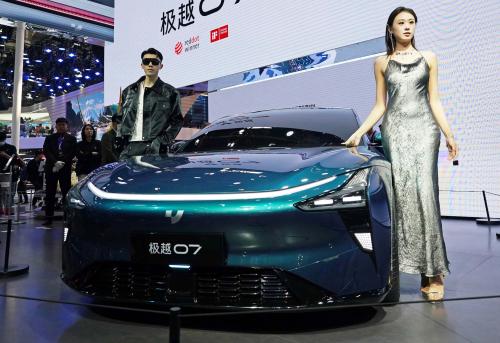Executive summary
 As the relationship between the United States and China deteriorates, the battle between the two powers for supremacy in low-carbon industries is leading the slide. From batteries to solar panels to rare-earth metals used in wind turbines, technologies that over the past decade have cratered in cost and surged in scale – thanks to innovation supported by both Washington and Beijing – are targets in yet another trans-Pacific trade fight.
As the relationship between the United States and China deteriorates, the battle between the two powers for supremacy in low-carbon industries is leading the slide. From batteries to solar panels to rare-earth metals used in wind turbines, technologies that over the past decade have cratered in cost and surged in scale – thanks to innovation supported by both Washington and Beijing – are targets in yet another trans-Pacific trade fight.
But investing in innovative green machines at home is only one way to affect the climate, and setting protectionist industrial policy is only one way to boost geopolitical power. At least as important to the planet is the money the United States and China spend on financing infrastructure in emerging markets and developing economies (EMDEs) — infrastructure that will lock in high or low carbon-emission pathways for decades. Never has it been more crucial that the two countries, even as they vie for supremacy in low-carbon innovation, support each other’s efforts to decarbonize their respective infrastructure finance flows.
China bankrolls more infrastructure in EMDEs than any other country. But much of that infrastructure has been dirty. According to a Boston University database, Chinese companies and so-called policy banks – large government-affiliated institutions – have financed 648 power plants in 92 countries.1 Of those plants’ collective power-generation capacity, more than 50% burn fossil fuel, and 34% burn the dirtiest sort of fossil fuel: coal. But China, facing criticism and sensing shifting economics, has pledged to change that. In November 2021, Chinese President Xi Jinping declared that his country “will step up support for other developing countries in developing green and low-carbon energy, and will not build new coal-fired power projects abroad.”2 Today, more than a year later, China must make good on that pledge through deep, structural changes to its political economy; otherwise, changes in its outbound investment will not take hold.
China’s task is daunting, threatening some of the biggest companies in China and thus in the world. It is even more intimidating because it looms at a time of perilous animosity between Washington and Beijing, evidenced by military brinkmanship over Taiwan, tit-for-tat trade barriers on products ranging from computer chips to solar panels, and superpower shadowboxing over Russia’s war in Ukraine. Yet China’s decarbonization of its foreign infrastructure finance is existentially important — for the planet, the Chinese economy, and U.S. citizens and firms. Contrary to the zero-sum view toward China that constitutes conventional wisdom in Washington, the winning strategy for the United States is not merely to try to eclipse China as an international financier of green infrastructure. The United States is trying to do that, notably through the Partnership for Global Infrastructure and Investment, a plan the administration of U.S. President Joe Biden and its G-7 allies announced last June to boost infrastructure investment in EMDEs, in large part to fight climate change. That effort was conceived broadly as a geopolitical counter to the Belt and Road Initiative (BRI), China’s decade-old infrastructure- and market-building campaign across the Global South, and to the BRI’s newer sibling, China’s Global Development Initiative (GDI).3 To be sure, a greening of U.S. and G-7 infrastructure investment abroad is needed and welcome. But it is insufficient. The smart strategy for the United States, even as it decarbonizes its own outbound infrastructure finance, is to encourage maximal greening of China’s massive infrastructure investment abroad — and to leverage that Chinese spending to create new opportunities for export-focused U.S. firms in a decarbonizing world.
-
Acknowledgements and disclosures
The author would like to thank Samantha Gross and Louison Sall for discussions related to this paper, Lori Merritt for editing, and Rachel Slattery for layout.
-
Footnotes
- Cecilia Springer, “Understanding China’s Global Power: 2022 Update,” (Boston, MA: Boston University, October 2022), https://www.bu.edu/gdp/2022/10/19/understanding-chinas-global-power-2022-update/#:~:text=A%20new%20policy%20brief%20summarizes,entire%20country%20of%20Spain%20or.
- Somini Sengupta and Rick Gladstone, “China Pledges to Stop Building Coal-Burning Power Plants Abroad,” The New York Times, September 21, 2021, https://www.nytimes.com/2021/09/21/climate/china-power-plants-coal.html.
- “Fact Sheet: President Biden and G7 Leaders Formally Launch the Partnership for Global Infrastructure and Investment,” The White House, June 26, 2022, https://www.whitehouse.gov/briefing-room/statements-releases/2022/06/26/fact-sheet-president-biden-and-g7-leaders-formally-launch-the-partnership-for-global-infrastructure-and-investment/.
The Brookings Institution is committed to quality, independence, and impact.
We are supported by a diverse array of funders. In line with our values and policies, each Brookings publication represents the sole views of its author(s).






